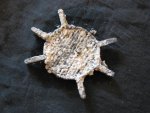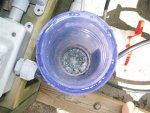I'm using a Waterway ClearWater Chlorinator (off-line) with chlorine pucks I've been getting from my local pool store in 7 kg pails. I believe they source their chemicals from Sani Marc Inc.
The problem I've been having lately is a gummy residue inside of my chlorinator. I've tried dissolving it with acid (acetic and muriatic) but acid doesn't affect it. I've been able to remove it mechanically with a brush and soapy water but it recurred after 1 charge of chlorine (11 pucks) and the photos are 24 days apart.
I mentioned this to the pool store's manager who then followed-up with her sales rep. She told me that no-one has complained about this before and the sales rep feels that this may have been the result of using a department store brand of chlorine. I did use a pail (8 kg) of HTH chlorine pucks that I got from Costco a few years ago but I've been using the store's brand of chlorine since.
FWIW, I drain my pool down every fall below the jets to winterize it and we get enough rain here that I have to periodically lower the pool level during the summer. For make-up, I use water from my pond, filtered to 5 microns.
Does anyone know why this residue forms and what would be the best way to prevent it from re-occurring?
The problem I've been having lately is a gummy residue inside of my chlorinator. I've tried dissolving it with acid (acetic and muriatic) but acid doesn't affect it. I've been able to remove it mechanically with a brush and soapy water but it recurred after 1 charge of chlorine (11 pucks) and the photos are 24 days apart.
I mentioned this to the pool store's manager who then followed-up with her sales rep. She told me that no-one has complained about this before and the sales rep feels that this may have been the result of using a department store brand of chlorine. I did use a pail (8 kg) of HTH chlorine pucks that I got from Costco a few years ago but I've been using the store's brand of chlorine since.
FWIW, I drain my pool down every fall below the jets to winterize it and we get enough rain here that I have to periodically lower the pool level during the summer. For make-up, I use water from my pond, filtered to 5 microns.
Does anyone know why this residue forms and what would be the best way to prevent it from re-occurring?



